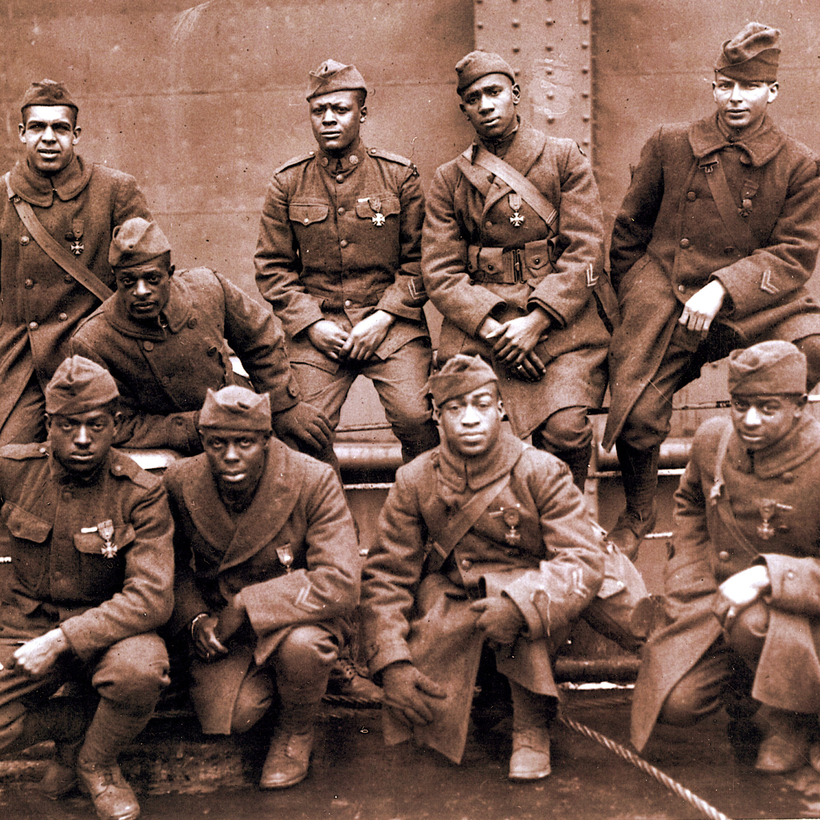It was late October 2000. A wide-eyed graduate student at the time, I had recently decided to write my dissertation on Black soldiers and World War I—what would eventually become my first book, Torchbearers of Democracy (2010). Now I was embarking on my first research trip to the University of Massachusetts-Amherst, whose library houses the papers of W. E. B. Du Bois.
I had, in advance, gone through the online finding aid. A nondescript reference to “Du Bois World War I materials” grabbed my attention.This might be promising, I thought.
When I arrived at the towering W. E. B. Du Bois Library, I went to the special-collections department. I introduced myself to the reference librarian and asked to see those “Du Bois World War I materials.” She departed, and I sat down to wait, not knowing what to expect. The librarian returned, carrying six microfilm reels. She placed them on the table before me. What could this possibly be?, I asked myself.

I loaded the first reel into the reader. I turned on the display and slowly advanced the film. I reached the first frame and, much to my surprise, saw a table of contents for what was an unfinished and unpublished manuscript by Du Bois on the Black experience in World War I. As I continued to make my way through the microfilm, the table of contents was followed by the actual manuscript itself, along with all of Du Bois’s research materials. The book possessed a remarkably evocative title: The Black Man and the Wounded World.
I cranked through the microfilm, furiously scribbling notes as quickly as possible and copying as many pages as I could on my limited graduate-student budget. I barely made it through the first reel. I left the library on that October afternoon shocked, thrilled, overwhelmed, and inspired to learn more about Du Bois’s largely unknown project.

In writing my new book, The Wounded World: W. E .B. Du Bois and the First World War, I spent countless hours immersed in Du Bois’s archival materials. My research yielded one surprise after another: rare military documents, personal letters from Black soldiers, diaries and memoirs, dozens of photographs, Du Bois’s correspondence with publishers, foundations, and other Black intellectuals related to his book.
And then there was The Black Man and the Wounded World itself. The full unfinished manuscript is 21 chapters and more than 800 pages long. It is a remarkable glimpse into Du Bois’s evolving historical understanding of the war.
Du Bois argued that the origins of the conflict lay in the competition among the European belligerents for imperial control of Africa and its people. He envisioned the book as a diasporic history, and drafted chapters on the roles of African soldiers in the French and British militaries. Other chapters revisited the challenges Blacks faced in supporting the war effort while still being treated as second-class citizens. Du Bois devoted the bulk of the manuscript to the experiences of Black soldiers, drafting hundreds of pages detailing every aspect of their service and, especially, the systemic racial discrimination they endured.

Why didn’t Du Bois finish what very well could have been one of his most significant works of history? Putting aside his pacifist beliefs, he initially supported the war, going so far as to encourage Blacks to “close ranks” with their fellow white Americans and set aside their “special grievances.” This decision would haunt him for the rest of his life.
In writing The Black Man and the Wounded World, he sought to make sense of the war, as well as find atonement. He was not successful. The war proved to be a subject too big, too personal, and too disillusioning for even the great Du Bois to master. As World War II tragically confirmed, World War I was a failure, one that also ultimately resulted in Du Bois’s failure to complete his book.
The surprising story of W. E. B. Du Bois’s forgotten epic history of the Black experience in World War I sheds new light on Du Bois’s life, work, and ideological evolution. It is also a reminder of the importance of World War I, why it mattered to Du Bois, and why it continues to matter today.

Chad L. Williams’s The Wounded World: W. E. B. Du Bois and the First World War is out now from Farrar, Straus and Giroux


